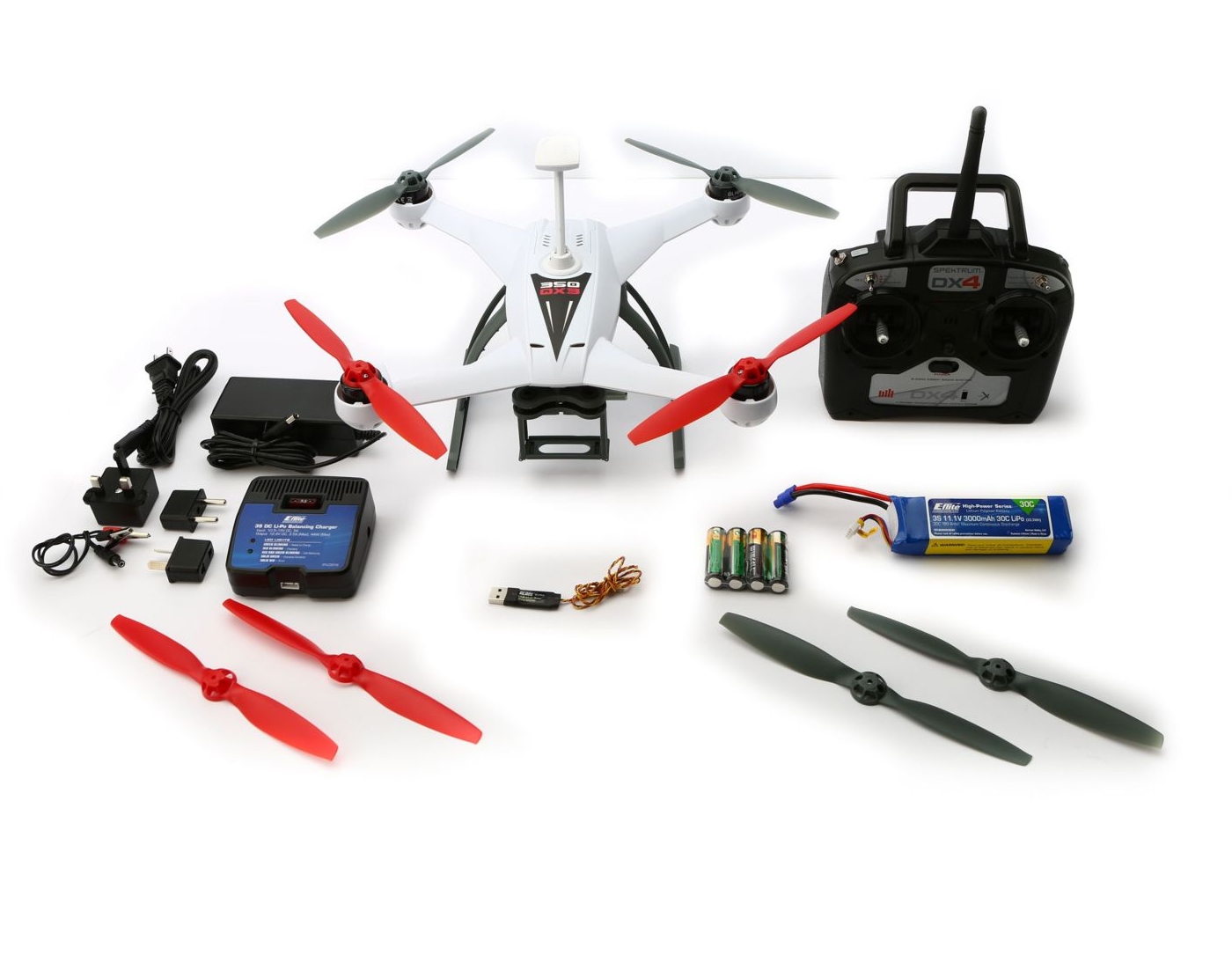What is a Racing Drone?
A racing Drone Kit, in essence, is a small quadcopter UAV or unmanned aerial vehicle. It is specifically designed to compete in first-person view or FPV racing events, most of which are held in major cities across the world. It is worth noting that racing drones are not similar to camera drones. The latter is more about being “slow and low” and is meant to capture high-quality videos of real estate, surfing contests, and landscapes, just to name a few. A drone FPV racer is not capable of doing these.
Transitioning from flying a pre-assembled racing drone to working on a DIY racing drone kit is a natural progression in your FPV journey. These drone racing kits serve as the ideal bridge between enjoying a ready-to-fly drone and constructing a custom racing quadcopter. While the contents of each kit may vary, a typical DIY drone racing kit includes all the essential components necessary for building your drone.
The kit’s contents can vary widely. Some kits are more basic, assuming you already have a headset or transmitter, making them suitable for beginners. However, if you’re looking for a comprehensive and foolproof solution, opting for a full-featured drone kit is a wise choice. This ensures that all components are compatible and designed to work seamlessly together, providing you with a high-performance racing drone.
If you’re too busy to delve into drone intricacies beyond battery charging and propeller replacement, drone kits might seem daunting. However, as you become acquainted with the components listed below, things may seem more manageable.
Batteries – These components supply the necessary power for your drones to take flight. Larger batteries offer increased power potential but can add extra weight. Finding the optimal balance between weight and power is critical, especially when pursuing speed.
Battery Charger – A charger is essential for replenishing your batteries once they’re depleted.
Camera – A high-quality camera significantly enhances your drone’s capabilities. It provides clear obstacle visibility, reduces the risk of collisions, and intensifies the overall flight experience.
Electronic Speed Controllers – These devices control your drone’s speed, allowing it to accelerate or decelerate in response to your radio transmitter inputs. They translate these inputs into the correct voltage, which is then sent to the motors.
Frame – The frame determines the shape and structure of your quadcopter, serving as the foundation for all other components. Opt for a lightweight frame when building a racing quadcopter to maximize speed and agility, as less weight means faster maneuverability.
Flight Controller – The flight controller acts as your drone’s central processing unit, a crucial component. Investing in a higher-quality flight controller provides better processing power, making your quadcopter smarter and more responsive than cheaper alternatives.
Goggles – When it comes to headsets, there is a range of options available, each with varying quality and prices. For example, you can find headsets for as low as $50, but they may provide pixelated images that can hinder your ability to navigate obstacles or enjoy the FPV flying experience fully. For a truly immersive experience, consider investing in high-quality headsets, even if they cost hundreds of dollars. The improved quality and experience they offer are well worth it.
Motors – Motors are responsible for powering your drone’s propellers, enabling it to fly. Typically, a quadcopter one motor for each propeller achieves faster flight speeds.
Propellers – Propellers are the spinning blades that generate lift and propulsion for your quadcopter. They come in various configurations, including 2, 3, or 4 blades, and can vary in size depending on the specific quadcopter.
Safety Glasses – When it comes to headsets, there are several options available, each of which differs in quality and price. For example, you can find headsets for as little as $50, but they can produce pixelated images that can prevent you from navigating obstacles or fully enjoying flying with FPV. To get a truly immersive experience, consider buying high-quality headsets, even if they cost hundreds of dollars. The improved quality and experience that make sure they offer are worth it.
Engines – The engines are responsible for powering the propellers of the quadcopter, allowing it to fly. As a rule, the quadcopter has one engine for each propeller to achieve higher flight speeds.
Propellers are rotating blades that create lift and traction for your quadcopter. They come in various configurations, including 2, 3, or 4 blades, and can vary in size depending on the specific quadcopter.
Power Distribution Board (PDB) – A power distribution board, often referred to as a PDB, serves as an electrical channel that directs power from your drone’s battery to various components such as the flight controller, receiver, and video transmitter. Think of it as your drone’s central nervous system transmitting electrical signals to all important parts.
Other Things You Will Ne
- Hex drivers
- Hot glue gun
- Pliers
- Soldering iron
- Tweezers
- Wire cutters
- Wrench
Best FPV Quadcopter Kit with Safety Glasses
Returning to our primary focus, let’s delve into the top FPV drone kits with goggles, examining their features and price points.
We will review the following best quadrocopters available in 2024:
Walkera Rodeo 110
The Walkera Rodeo 110 is a compact FPV racing drone designed for beginners. It features a 110mm base size and weighs just 100g without the battery. Equipped with an 850mAh battery, it offers a flight time of approximately 6 minutes. The drone is powered by high-performance mini brushless motors, allowing it to reach speeds of up to 44 miles per hour (70 kph). Each motor is paired with lightweight 3-blade propellers to generate thrust.
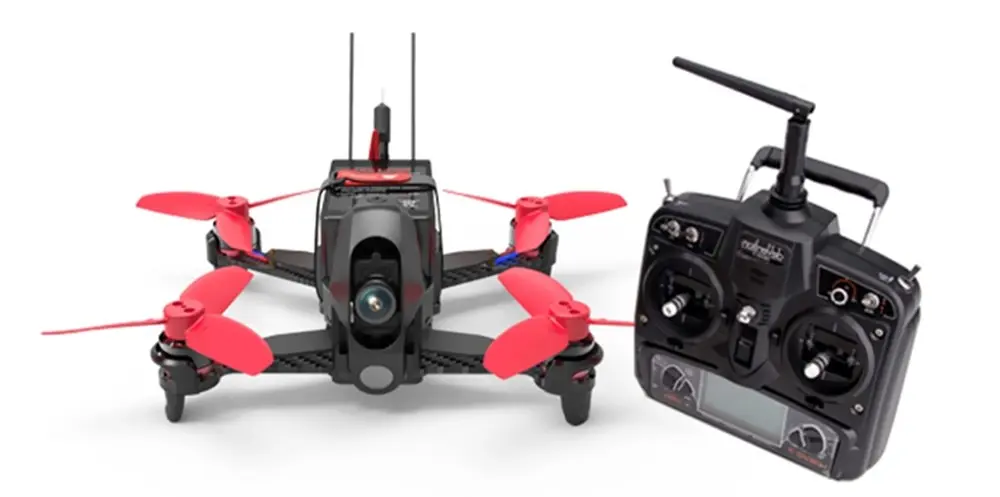
The Walkera Rodeo 110 is a BNF (Bind N Fly) drone, meaning it comes ready to fly but requires a separate PPM or SBUS-compatible receiver for operation. The flight controller has an output port for connecting the radio receiver. Some sellers may offer a Ready To Fly (RTF) kit that includes a pre-bound controller.
The quadcopter features a 600TVL HD camera with an adjustable angle ranging from 0 to 45 degrees. It also includes a bright LED light in front of the camera to improve visibility in darker flight environments. While the Walkera Rodeo 110 may not be a top competitor in racing competitions, it provides an enjoyable flying experience.
Price-wise, the Walkera Rodeo 110 is currently priced at $175.99 on Amazon, but it’s advisable to check for the latest pricing on the platform.
Fat Shark 101
The FatShark 101 serves as an ideal trainer quadcopter for individuals who are new to the world. This quadcopter features a compact design, measuring 13 inches in length and 9 inches in width, with a weight of approximately 2 pounds.
Powering the FatShark 101 are brushed motors paired with 2-blade propellers, along with a LiPo battery that offers a flight duration ranging from 5 to 8 minutes. The actual flight time may vary depending on your flying style and usage.
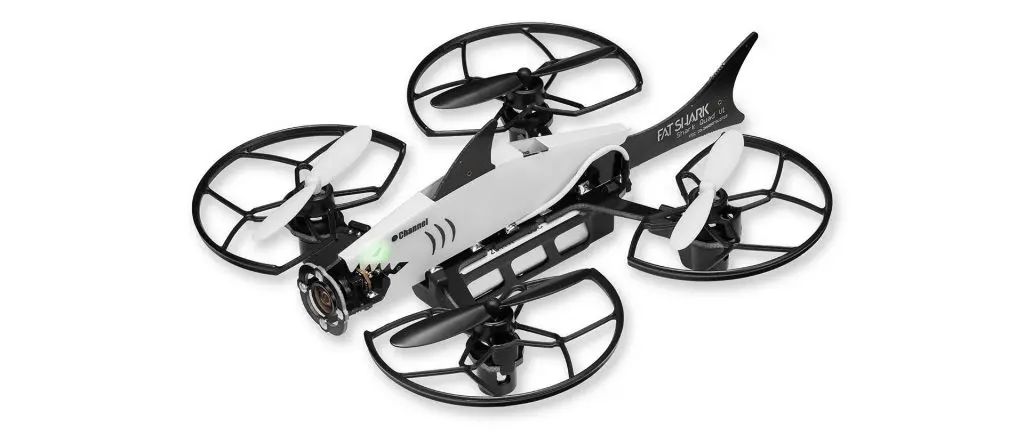
The elongated design of the FatShark 101, resembling a shark, ready to fly imparts excellent agility and maneuverability to the quadcopter, making it well-suited for performing acrobatics and navigating through obstacles. The FPV camera is fixed on the front of the quadcopter and lacks adjustability, which is less significant for beginners.
A notable feature of the FatShark 101 is its inclusion of a DRILL simulator license key, which is particularly beneficial for novice pilots. This quadcopter is available as an RTF (Ready-To-Fly) package, eliminating the need for additional accessories such as a remote control or goggles to start flying.
Price-wise, the FatShark 101 is currently listed on Amazon for a price of $246.39 at the time of composing this article. Prices may fluctuate, so it’s advisable to check Amazon.com for the most up-to-date pricing information by clicking the provided link below.
Walkera F210 3D Edition
Now, let’s delve into new the realm of professional racing drones with a closer look at the Walkera F210 3D Edition. This high-performance racer is equipped with powerful motors and a sturdy carbon fiber frame, making it a formidable choice for professional racing.
The Walkera F210 3D Edition is a ready-to-fly package, providing all the necessary accessories straight out of the box, except for the goggles. It boasts a cutting-edge, F3D, which leverages advanced sensors to enhance the F210’s flight capabilities. Furthermore, this drone can be connected to a computer, allowing users to customize and program advanced settings for more precise and tailored flying experiences.
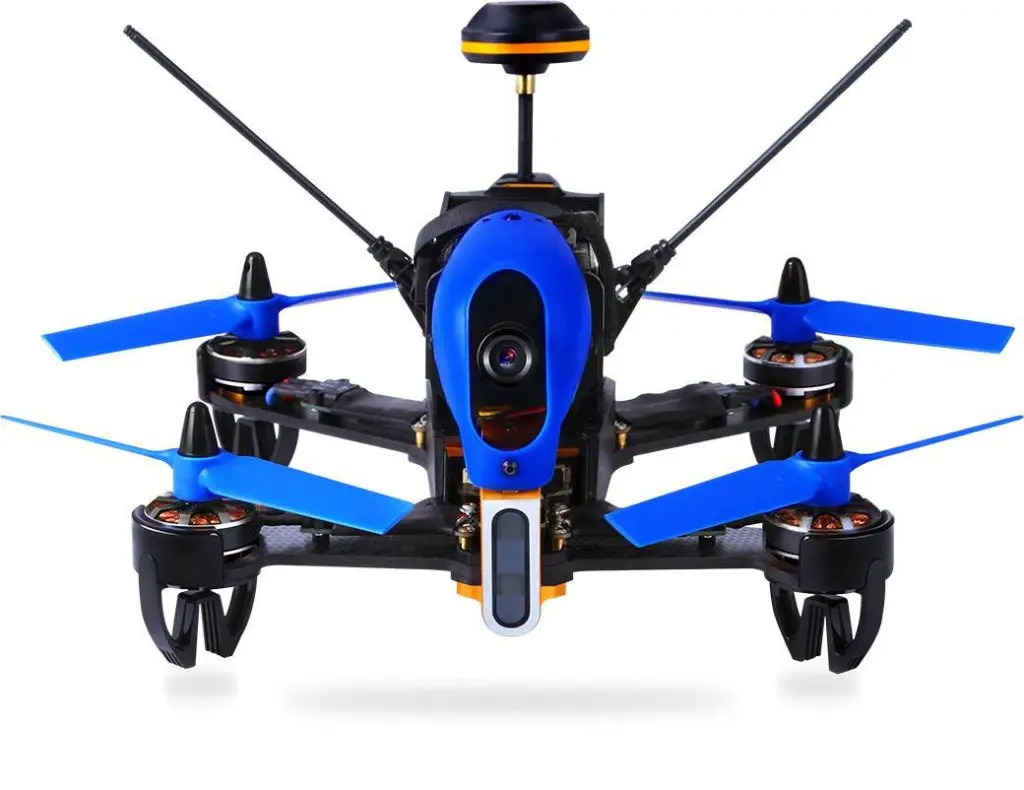
The Walkera F210 features an impressive HD 700 TVL camera with a wide 120-degree field of view (FOV), perfect for capturing the thrill of high-speed racing. Additionally, it comes equipped with infrared night vision capabilities, adding versatility to its use in closed-circuit races or nighttime flights.
This Fpv drone boasts high-performance brushless motors, complemented by specially designed ESC (Electronic Speed Controllers), resulting in rapid acceleration. The ESC also has the unique ability to reverse the motor’s polarity, allowing for instant course reversals during flight. It relies on a 1300mAh LiPo battery in a 4S configuration, providing a flight time ranging from 6 to 9 minutes. The transmitter or remote controller included is the standard Devo-7, featuring an on-screen display (OSD) that offers valuable telemetry data during flight.
Price: As of now, the Walkera F210 3D Edition is priced at $419.99 on Amazon. However, prices may fluctuate, so be sure to click the button below to check the current price and availability.
Hubsan X4 H122D Storm
The Hubsan X4 Storm offers an affordable option for drone racing enthusiasts. It comes as a ready-to-fly unit, eliminating the need to purchase a separate transmitter for flying the FPV racing drone However, it’s worth noting that you will need to invest in separate FPV goggles. Fortunately, the transmitter included with the X4 is compatible with Fatshark FPV goggles, providing a convenient option for immersive racing experiences.
One standout feature of the X4 is its impressive 720p HD camera, a noteworthy inclusion considering that many other racing drones, even at higher price points, often come with non-HD TVL cameras. Unlike older analog TVL cameras, the X4’s camera can transmit a high-definition FPV stream, record high-quality videos, and capture aerial photos. Despite its compact size, the X4 boasts a sturdy build, offering both lightweight performance and durability, making it resilient to crashes. Powered by a 710mAh LiPo battery, it provides a maximum flight time of approximately 6 minutes, making it an ideal choice for beginners, all at an attractive price point.
Price: The Hubsan X4 H122D Storm is available for just $80 at the time of writing this article. To check the latest price, please click the below button to see it on Amazon.
EMAX Tinyhawk
The EMAX Tiny Hawk is another excellent ready-to-fly (RTF) quadcopter, complete with its FPV goggles and remote controller. As its name suggests, the Tiny Hawk lives up to its reputation as a truly compact quadcopter, fitting comfortably in the palm of your hand. Unlike many other racing drones, the Tiny Hawk is designed with beginners in mind, making it an approachable choice with rights reserved.
What sets this search quadcopter apart is its unique design, departing from the typical off-the-shelf components seen in the quadcopter world. Despite its small size, the Tiny Hawk is equipped with powerful brushless motors, ensuring efficient and reliable performance. Notably, the motors are installed in an inverted position, and the quadcopter features non-removable prop guards for added safety and convenience.
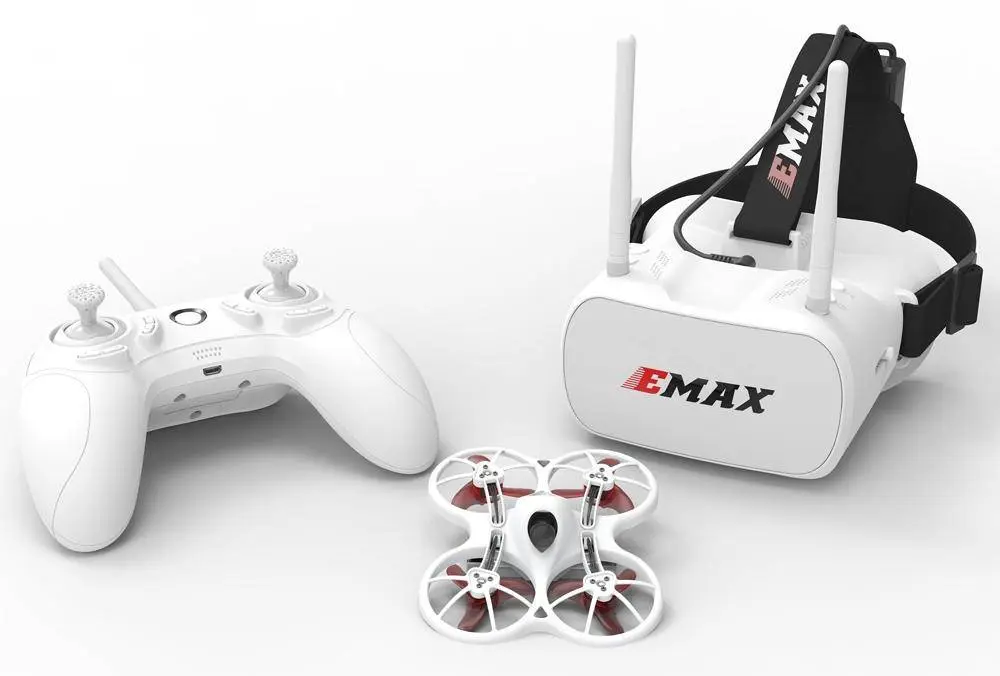
What’s more, the EMAX Tinyhawk comes with a portable carrying case, enhancing its portability and making it ideal for travel. You also have the option to purchase the case separately if needed.
The drone is powered by a small 45mAh 1S battery, providing a flight time of around 4 minutes. While the flight time isn’t that extensive, you can extend your airtime by acquiring additional batteries from EMAX.
Price: At the time of writing this post, the EMAX Tinyhawk is available for $223. Please note that prices are subject to change, so be sure to check the current price by clicking the button below.
iFlight ProTek25 Pusher CineWhoop FPV
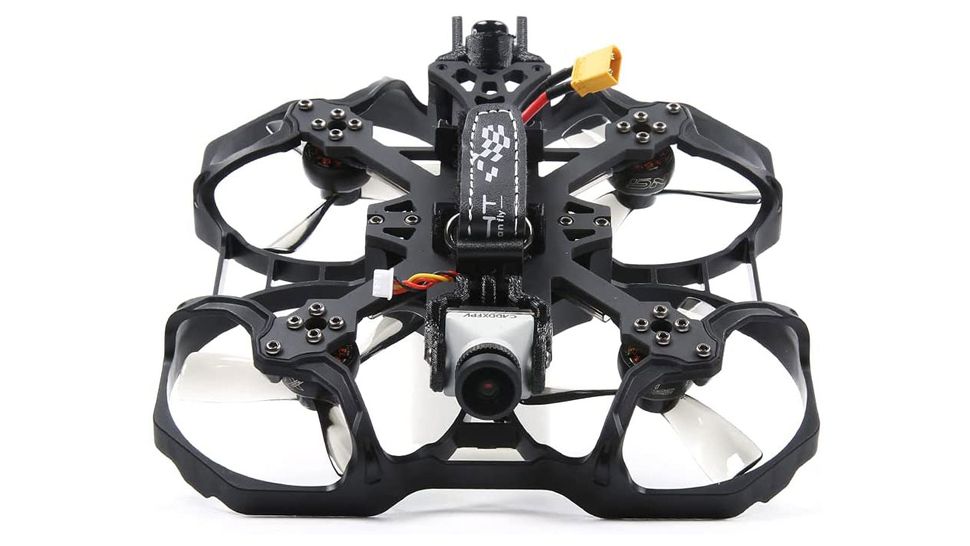
Specifications
Reasons to buy
- Low vibration frame (better footage)
- Beginner-friendly packaging
- Powerful enough to lift GoPro 9 or 10
Reasons to. Bring your goggles
Аvoid. No pairing instructions or video
Like it or not, the historical chain of names ending in days get“—whoop” has now become part of the quadrocopter lore, and it’s a cinematic helicopter, which means it’s capable of lifting a GoPro, but not too dangerous not to use it up close. The word “pusher” in the product name refers to the inverted arrangement of the engine, which makes it look a bit like a skeletal hovercraft, but creates the effect of cleaner airflow under the aircraft for smoother flight (and, as a result, smoother video).
Racing Drone Kit Frequently Asked Questions
What is the difference between FPV?
Questions revolve around the goal of completing an obstacle race course as swiftly as possible. On the other hand, FPV freestyle introduces an additional layer of complexity. It entails skillfully searching and maneuvering through challenging terrains, including tight corners, dense foliage, obstacle-laden paths, and narrow openings, all while performing a variety of impressive aerial tricks and stunts.
List how far a quadcopter can fly.
New Most high-end drones can fly about 5 kilometers or more. And with improved technology and battery life, it is not uncommon for some drones to be able to fly 10 km or more.
What is the best FPV drone size?
By far the most common frame is around 210mm, which most people would refer to as a 5-inch frame. This is used in both freestyle and race get as it is often the best compromise between power, weight, and responsiveness.
How fast can Drones Racing fly?
Some new models can reach around 70 mph. Quadcopters, however, will often be clocked at over 100 mph, with the world record being set at 179 mph. A military predator Quadcopter closes in on a target at a surprisingly slow 135 mph.
What drones do professional drone racers use?
A small new selection of drones can reach speeds of over 100 mph with many quadcopters able to reach speeds of between 70-100 mph. Important information: pilots in the Quadcopter League exclusively fly the Racer and Racer 3 Quadcopter both manufactured by the League.
Are daycare FPV drones illegal?
The use of quadrocopter parts and goggles is legal in both the United Kingdom and the United States, but to fly an FPV you’ll need an observer who can maintain a visual line of sight with the aircraft and communicate this with the pilot.
How much do FPV drone racers make?
The Drone Racing League pays an average salary of $369,287 and salaries range from a low of $325,710 to a high of $420,795.
Conclusion
In conclusion, a racing drone kit opens up a world of excitement and adventure for both beginners and experienced enthusiasts. These kits provide an excellent opportunity to build and customize your high-speed drone to suit your preferences and racing style. Whether you’re looking for the thrill of participating in FPV races or simply enjoying exhilarating flights, a racing drone kit equips you with the tools and knowledge to elevate your drone piloting skills to new heights. So, whether you’re chasing the adrenaline rush of speed or exploring the art of FPV freestyle, a racing drone kit is your ticket to exciting possibilities in the world of drone racing. Get ready to take to the skies and experience the thrill of racing like never before with your racing drone kit.

